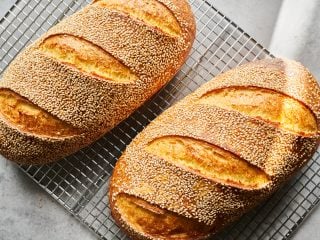Description
Pane Siciliano is a traditional bread from Sicily made with durum wheat (semolina), sometimes a little olive oil (as I do in this recipe), and even sweeteners such as honey or barley malt syrup. The flavor is nutty, sweet, and with a buttery mouthfeel, thanks to the olive oil. The sesame seeds densely coating the exterior bring a peanut butter-like flavor and nuttiness that I find irresistible.
Ingredients
Levain
- 109g durum flour
- 65g water
- 11g ripe sourdough starter (100% hydration)
Autolyse
- 882g durum flour
- 628g water
Main Dough
- 35g extra-virgin olive oil
- 50g water
- 20g fine sea salt
- 185g ripe levain
Instructions
- Levain (9:00 p.m.)
In a small bowl mix the Levain ingredients. Cover the jar and keep it at a warm temperature overnight. - Autolyse (8:00 a.m)
In a mixing bowl, add the Autolyse ingredients until no dry bits remain. Cover the bowl and let rest for 1-hour. - Mix (9:00 a.m.)
Add the salt and levain to the top of the dough in autolyse and use a splash of the remaining water to moisten. With wet hands, mix thoroughly. Add the remaining water if the dough feels like it can handle it. Knead the dough for a few minutes using either the slap and fold technique or folds in the bowl until the dough smooths and becomes elastic. Transfer the dough back into the bowl. Spread the olive oil over the top and pinch it into the dough. Mix the oil into the dough by folding it up and over for 3 to 4 minutes. Transfer the dough to a bulk fermentation container and cover. - Bulk Fermentation (9:30 a.m. to 12:30 p.m.)
This dough will require 2 sets of stretches and folds during bulk fermentation at 30-minute intervals. After the second set, let the dough rest, covered, for the remainder of bulk fermentation. - Divide and Preshape (12:30 p.m.)
Scrape the dough out to a clean work surface. Use water and a wet hand, and your bench knife, divide the dough in half. Lightly shape each half into a round shape and let rest for 30 minutes, uncovered. - Shape (1:00 p.m.)
Place a baking sheet or clean kitchen towel next to your work surface and spread an even layer of white sesame seeds on top. Flour the top of the preshaped round and your work surface. Using your bench knife, flip one of the rounds over onto the floured area. Using floured hands, shape the dough into a bâtard. Transfer the shaped dough, seam-side up, to the pan with sesame seeds and rock it back and forth so the seeds stick. Gently transfer the dough to an 11-inch long proofing basket, seam-side up. Repeat with the remaining round. - Proof (1:30 p.m. to 9:00 a.m. the next day)
Cover proofing baskets with reusable plastic, seal, and place into the refrigerator overnight. - Bake (The next day, 9:00 a.m.)
Place an oven rack in the bottom-third of the oven with a baking surface on top and preheat to 450°F (230°C). Take one of the proofing baskets out of the fridge, uncover it, and put a piece of parchment paper over the basket. Place a pizza peel or inverted baking sheet on top of the parchment, and using both hands, flip everything over. Remove the basket and score the dough. Repeat with the other basket. Slide the dough into the oven, side by size. Steam the oven by pouring ice into the preheated pan at the bottom of the oven. Bake for 20 minutes. Vent the oven of steam by removing the steaming pans. Continue to bake for 35 minutes more. When done, the loaf should have an internal temperature of around 204°F (95°C), and the crust should be golden-colored. Let the loaves cool on a wire rack for 1 to 2 hours before slicing.
Notes
The extra-virgin olive oil can be left out of this recipe with no other changes.
